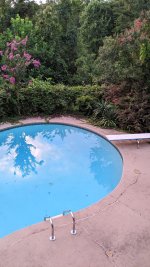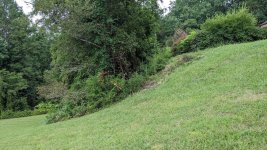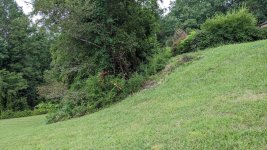Hairline crack developed in bottom of old gunite pool and apparently caused a slight leak. Crack has been filled with pool putty and leak apparently ended for now but what might i expect in the future? I will continue to monitor the situation. What else, if anything, would you suggest doing now, based on following info? I apologize for the lengthiness of this post, but it is a scary situation.
25,000 gallon in-ground gunite pool, with concrete slab decking, built in 1981 at the edge of a steep hillside -- the land had been graded/terraced to obtain a flat area for construction of the pool and the adjoining house. The ground is heavy red clay. One side of the pool is parallel to, and right up against, the downhill side of the remaining slope. We bought the place in 2007.
two causes for concern which existed in 2007:
1. The ground on the downhill side of the pool had apparently sunk down several inches, such that a section of deck slab on that side was tilted downhill a few degrees more than might otherwise be expected, and the edge of one of the slab was completely exposed and even had a visible gap of a few inches between the bottom of the slab and the earth underneath it. Other deck slabs had also shifted and cracked, both on the downhill side as well as on the uphill side where a tree had been planted too close to the pool. Attached photo shows slabs had cracked in a ring pattern around the pool. The flowering trees (crepe myrtle) in the pic are on the downhill side.
2. The pool vessel itself is not level -- the water level on the downhill side of the pool is closer to the upper edge of the tiles than it is on the uphill side of the pool, indicating that the whole pool had tilted slightly downhill. I began measuring the delta a few times a year about 10 years ago and it has remained constant at 1 15/16 inches to the best level of precision i can achieve.
I have of course been hoping that the ground has stabilized since 1981.
My understanding is that the pool vessel shell and the decking are not a one piece construction -- that the decking slabs basically just sit on the ground surrounding the pool.
I had the deck sections slabjacked in 2012 and filled the cracks with self-leveling compound. The deck sections and filled cracks have seemed pretty stable since then, except for one section on the downhill side which seems to have shifted such that the edge along the pool has raised up a fraction of an inch.
I had the pool replastered with plain white plaster in 2017. I didn't do a good job balancing the water after that and the plaster shows it.
Last year i noticed the hairline crack, several feet long in the bottom. It had probably been there before, smaller, without my noticing. I could not tell that the pool was leaking. The crack runs semi-parallel to the area of the hillside which seems to have sunk the most.
After noticing the crack, I had a foundation engineer come eyeball the hillside. He probed the soil in several places and observed the vegetation and said he did not see any current signs of instability. There are several fair-sized trees on the hillside downhill from the pool, and he pointed out that their trunks are vertically straight -- which would not be the case if the ground had recently been shifting downhill. At least nothing significant.
This month i had a diver come and do a dye test on the crack, and he said there did seem to be a slight leak in a 12-inch section. He filled the entire crack with pool putty and did another dye test and saw no more leaking.
I will monitor things -- bucket test for leaks, watch the crack, have the diver back for another dye test at some point, continue to measure the water level delta, monitor any further movement in the deck slab, monitor the angle on the fence around the pool to see if it seems to be moving downhill.
What else, if anything, would you consider doing at this point? Build the hillside back up by adding soil? Staple the pool shell? These would both be major projects and i'm not sure they would do any good. Also i'm not sure anyone around here knows how to do stapling.
Thoughts? Questions? Thanks.
25,000 gallon in-ground gunite pool, with concrete slab decking, built in 1981 at the edge of a steep hillside -- the land had been graded/terraced to obtain a flat area for construction of the pool and the adjoining house. The ground is heavy red clay. One side of the pool is parallel to, and right up against, the downhill side of the remaining slope. We bought the place in 2007.
two causes for concern which existed in 2007:
1. The ground on the downhill side of the pool had apparently sunk down several inches, such that a section of deck slab on that side was tilted downhill a few degrees more than might otherwise be expected, and the edge of one of the slab was completely exposed and even had a visible gap of a few inches between the bottom of the slab and the earth underneath it. Other deck slabs had also shifted and cracked, both on the downhill side as well as on the uphill side where a tree had been planted too close to the pool. Attached photo shows slabs had cracked in a ring pattern around the pool. The flowering trees (crepe myrtle) in the pic are on the downhill side.
2. The pool vessel itself is not level -- the water level on the downhill side of the pool is closer to the upper edge of the tiles than it is on the uphill side of the pool, indicating that the whole pool had tilted slightly downhill. I began measuring the delta a few times a year about 10 years ago and it has remained constant at 1 15/16 inches to the best level of precision i can achieve.
I have of course been hoping that the ground has stabilized since 1981.
My understanding is that the pool vessel shell and the decking are not a one piece construction -- that the decking slabs basically just sit on the ground surrounding the pool.
I had the deck sections slabjacked in 2012 and filled the cracks with self-leveling compound. The deck sections and filled cracks have seemed pretty stable since then, except for one section on the downhill side which seems to have shifted such that the edge along the pool has raised up a fraction of an inch.
I had the pool replastered with plain white plaster in 2017. I didn't do a good job balancing the water after that and the plaster shows it.
Last year i noticed the hairline crack, several feet long in the bottom. It had probably been there before, smaller, without my noticing. I could not tell that the pool was leaking. The crack runs semi-parallel to the area of the hillside which seems to have sunk the most.
After noticing the crack, I had a foundation engineer come eyeball the hillside. He probed the soil in several places and observed the vegetation and said he did not see any current signs of instability. There are several fair-sized trees on the hillside downhill from the pool, and he pointed out that their trunks are vertically straight -- which would not be the case if the ground had recently been shifting downhill. At least nothing significant.
This month i had a diver come and do a dye test on the crack, and he said there did seem to be a slight leak in a 12-inch section. He filled the entire crack with pool putty and did another dye test and saw no more leaking.
I will monitor things -- bucket test for leaks, watch the crack, have the diver back for another dye test at some point, continue to measure the water level delta, monitor any further movement in the deck slab, monitor the angle on the fence around the pool to see if it seems to be moving downhill.
What else, if anything, would you consider doing at this point? Build the hillside back up by adding soil? Staple the pool shell? These would both be major projects and i'm not sure they would do any good. Also i'm not sure anyone around here knows how to do stapling.
Thoughts? Questions? Thanks.




